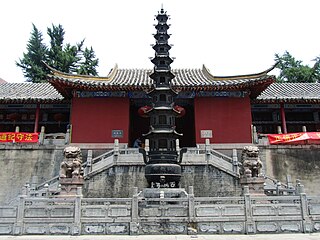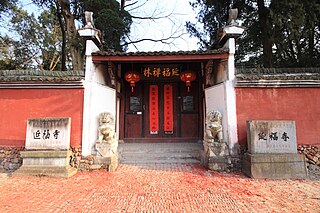
Yunju Temple is a Buddhist temple located in Fangshan District, 70 kilometers (43 mi) southwest of Beijing and contains the world's largest collection of stone Buddhist sutra steles in the world. Yunju Temple also contains one of only two extant woodblocks for the Chinese Buddhist Tripitaka in the world as well as rare copies of printed and manuscript Chinese Buddhist Tripitakas. It also has many historic pagodas dating from the Tang and Liao Dynasty.

Tianmenshan Temple is a Buddhist temple located in Tianmen Mountain of Zhangjiajie, Hunan, China. The temple is built within grounds of some 20,000 square metres (220,000 sq ft) area.

Tiantong Temple is a Buddhist temple located in Taibai Mountain of Yinzhou District, Ningbo, Zhejiang, in the People's Republic of China. The temple covers a total area of 76,400 square metres (822,000 sq ft), with more than 38,800 square metres (418,000 sq ft) of floor space. Tiantong Temple is listed as one of the "Five Chan Buddhism Temples". Tiantong Temple is the cradle of the Sōtō school of Japanese Buddhism.

The Dafo Temple is a Buddhist temple in Guangzhou, Guangdong, China. Located in Yuexiu District, Dafo Temple is a grand temple with a history of more than one thousand years and was built by Emperor Liu Yan in the Southern Han dynasty (917–971). It has been praised as one of the "Five Largest Temples of Guangzhou" in history. Later it was destroyed and rebuilt many times. In the late Ming dynasty, the temple was declining day by day and was devastated by the war while Shang Kexi and Geng Jimao conquered Guangdong in 1649. During the reign of the Kangxi Emperor in 1663, the temple was rebuilt and expanded by Shang Kexi continuously. According to the national policy of free religious belief, the temple was approved by the Guangzhou Municipal People's Government to be restored as a Buddhist temple in 1981. Then Master Guangming, vice-president of the Guangzhou Buddhist Association, served as abbot; he tried to revitalize Dafo Temple and restore the style of the large temple. On August 9, 1993, Dafo Temple was put on the list as a Municipality Protected Historic Site by the Guangzhou Municipal People's Government.

Kaiyuan Temple is a Buddhist temple located in Xiangqiao District of Chaozhou, Guangdong, China.
Dizang Temple is a Buddhist temple located in Fuzhou, Fujian, China. Now It is a Bhiksuni temple of Caodong school.

Daci'en Temple is a Buddhist temple located in Yanta District, Xi'an, Shaanxi. The temple is the cradle of East Asian Yogācāra in China. It is notable for the Giant Wild Goose Pagoda. The pagoda was originally built by an accomplished monk Xuanzang, whose story was widespread in civil society in many dynasties and the famous legendary story Journey to the West was inspired by his experience. Alongside Daxingshan Temple and Jianfu Temple, it was one of the three sutras translation sites (三大译经场) in the Tang dynasty.

Luohan Temple is a Buddhist temple located in Yuzhong District, Chongqing. It is the site of the Buddhist Association of Chongqing. The temple was used for Ning Hao's black comedy film Crazy Stone.

Temple of King Ashoka is a Buddhist temple located in Yinzhou District of Ningbo, Zhejiang, China.

Gaoming Temple is a Buddhist temple located in Tiantai County, Zhejiang, China.

Huayan Temple or Huayan Monastery is a Buddhist temple located in Datong, Shanxi, China.

Mingjiao Temple, formerly known as Iron Buddha Temple, is a Buddhist temple located in the Luyang District of Hefei, Anhui, China. Mingjiao Temple was originally built in the early 6th century, but because of war and natural disasters has been rebuilt numerous times since then. The present version was renovated and redecorated in 2015.

Langya Temple is a Buddhist temple located on Mount Langya (琅琊山), in Langya District of Chuzhou, Anhui, China.
Ciyun Temple is a Buddhist temple located at the foot of Mount Lion (狮子山) in Nan'an District, Chongqing.

Hualin Temple is a Buddhist temple located in Gulou District, Fuzhou, Fujian, China. After the introduction of Chan Buddhism from China to Japan in the Song dynasty (960–1279), the architectural style of Song dynasty have a profound influence on Japan traditional cultural and folk customs. The oldest things in the temple is the Main Hall, which was built in the early Song dynasty (960–1279).

Yanfu Temple or Yanfu Chan Temple is a Buddhist temple located in Wuyi County, Zhejiang, China. The Mahavira Hall is the earliest Yuan dynasty (1271–1368) architecture and one of the three Yuan dynasty wooden architecture in Jiangnan.

Chongfa Temple is a former Buddhist temple located within the Renmin Park, in Tianning District of Changzhou, Jiangsu, China.

Longquan Temple is a Buddhist temple located on Mount Longquan, in Yuyao, Zhejiang, China.

Yunxiu Temple is a Buddhist temple located in Xiazhuhu Subdistrict, Deqing County, Zhejiang, China.

Huguo Temple is a Buddhist temple located on the top of Mount Danxia, in the town of Danxia, Panzhou, Guizhou, China.



















